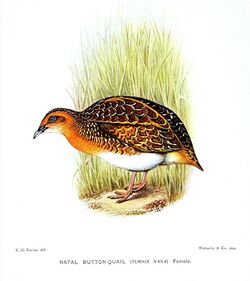Biology:Black-rumped buttonquail
| Black-rumped buttonquail | |
|---|---|

| |
| Scientific classification Error creating thumbnail: Unable to save thumbnail to destination
| |
| Domain: | Eukaryota |
| Kingdom: | Animalia |
| Phylum: | Chordata |
| Class: | Aves |
| Order: | Charadriiformes |
| Family: | Turnicidae |
| Genus: | Turnix |
| Species: | T. nanus
|
| Binomial name | |
| Turnix nanus (Sundevall, 1850)
| |
The black-rumped buttonquail (Turnix nanus) is a small species of bird in the buttonquail family.
Description
This species has a brown back, rufous chest, and pale belly, brown irises and a black rump. As usual for buttonquails but not for most birds, the female is larger and brighter than the male. The birds are shy and difficult to flush.
Taxonomy and systematics
The Black-rumped buttonquail, scientific name Turnix nanus, belongs to the family Turnicidae, which includes buttonquails or hemipodes. The family is part of the order Charadriiformes, which also contains shorebirds, gulls, and auks. The Turnicidae family consists of 16 species of buttonquails found in Asia, Africa, and Australia. The Black-rumped buttonquail was first described by the British naturalist Thomas Horsfield in 1821. The species was initially classified as Tetrao nanus but later placed in the genus Turnix. The Black-rumped buttonquail is one of the smallest buttonquail species, measuring only about 15 cm (6 in) in length and weighing around 30 g (1 oz). There are no recognized subspecies of the Black-rumped buttonquail, but the species does exhibit some genetic diversity across its range. In recent years, genetic studies have helped to clarify the evolutionary relationships within the Turnicidae family and have led to the recognition of several new species. Overall, the Black-rumped buttonquail has a relatively well-understood taxonomy, but further research is needed to fully understand the genetic diversity and relationships within the Turnicidae family.
Distribution and habitat
The species is found in open grassland through much of Africa outside the forested and more arid regions. It is resident in the central parts of the range but is a migratory breeder further north towards Lake Chad and the Central African Republic.
References
- ↑ BirdLife International (2019). "Turnix nanus". IUCN Red List of Threatened Species 2019: e.T22725531A155630512. doi:10.2305/IUCN.UK.2019-3.RLTS.T22725531A155630512.en. https://www.iucnredlist.org/species/22725531/155630512. Retrieved 13 November 2021.
- Madge and McGowan, Pheasants, Partridges and Grouse ISBN:0-7136-3966-0
- Sinclair, Ian; Hockey, Phil; Tarboton, Warwick (2002). SASOL Birds of Southern Africa. Struik. ISBN 1-86872-721-1.
External links
- Black-rumped buttonquail - Species text in The Atlas of Southern African Birds.
- Black-rumped buttonquail - Black-rumped buttonquail: Care, Health, Mutations.
Wikidata ☰ Q3542358 entry
 |


